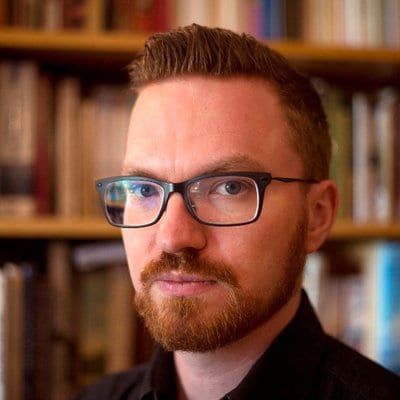The American journalist Max Blumenthal’s last book, Goliath: Life and Loathing in Greater Israel, was infamously and sarcastically denounced as part of the “Hamas Book-of-the-Month Club” by Blumenthal’s former colleague at The Nation Eric Alterman.
The furore in The Nation over Max’s book when it came out in 2013 (Alterman denounced it over the course of no less than 10 tedious and scurrilously obsessive articles) was not reflected in the wider mainstream media. Instead, it was, for the most part, strictly ignored.
This is surprising given that Max’s first book Republican Gommorah: Inside the Movement that Shattered the Party was a New York Times best-seller and was praised by CNN, NPR and in the “paper of record” itself. It’s perhaps even more surprising given his family background. Max’s father Sidney was an aide to former President Bill Clinton, and is still considered close to the Clintons.
But then again we are talking about Israel, which is the third rail in US politics; the hot button subject, a state it is never done to criticise in polite circles. One would perhaps have expected the book to be attacked more, but its critics probably knew they would only draw more attention to it and risk people actually reading it and being informed about the hell hole of fascism and racism that Israeli is descending into.
Max has a new book out this month called The 51 Day War. He went over to report from Gaza during the war last year and this new account is the result of his work there.
With this new book, Max has outdone himself. This is the definitive account of the 2014 Israeli war on Gaza. Max combines the very best of humanistic, on-the-ground journalism with detailed documentation backing up every point he makes.
And he covers every aspect. Through his eyes, and the eyes of his colleagues, contacts and friends in Gaza, we see the ruins, the rubble, the pain, death and destruction inflicted on the people of Gaza by Israel and its allies. We see hope and despair, but most of all we see the Palestinians people themselves.
In The 51 Day War, Max has an important section covering the military aspects of the war. But where the corporate media covering this would probably focus on the might and majesty of Israel’s overwhelming military force and its praise-worthy ability to kill Palestinian children, Max documents a most under covered aspect of the war: the defensive liberation struggle of the Palestinian resistance factions, led by Hamas, Palestine’s Islamic resistance movement.
Max lays out a short and readable history of the al-Qassam Bridages, Hamas’s military wing. He shows how the suicide bombings of the 1990s and 2000s were a reaction to Israel’s systematic killings of Palestinians civilians, and a desire to strike back at the oppressor. The first Palestinian suicide bombing in 1994 was a direct reaction to the infamous Hebron massacre of 29 Palestinian Muslims as they worshipped in a Mosque.
That act of Israeli terrorism may have been carried out by an “extremist” individual, but the historical record shows that the Israeli government reacted by taking the side of the radical settlers and the Jewish Defence League/Kach who perpetrated the murders by shutting down Hebron for Palestinians, collectively punishing them and annexing part of the Ibrahimi mosque so it could be used as a synagogue for the first time ever. All this to appease the fanatic racist Jewish extremists who colonise Hebron, because they believe God gave them the land.
Max shows that Hamas’s military resistance in recent years has taken a new course and has made a point of targeting Israeli military forces and avoiding civilian targets. This, even as Israel has only ramped-up its deliberate targeting of Palestinian and other Arab civilians. About 70 percent of the 2,200 Palestinians killed in the 2014 Gaza war were civilians, including 550 children. The vast majority of the Israelis killed in the war were soldiers.
Even for people like myself, who closely followed the course of the July-August 2014 Israeli attack on Gaza, I learned many new things from this book. At the hight of the war, the Israeli minister of “internal security” issued a ban on all demonstrations against the war, shutting down the small number of Israeli dissidents. “We need to unite as a country and support the IDF [Israeli army] soldiers who are fighting [in Gaza],” he said.
This book is also painfully honest. This a searing account which holds nothing back. It is reflective and self-critical. In an account of the traumatic reality for Palestinian doctors in a Gaza hospital facing so much death and destruction, some doctors were frustrated. Max writes: “I encountered a moustachioed, middle-aged surgeon who demanded to know how much money Dan and I were making as journalists, accusing us of cashing in on Palestinian misery. A portly doctor chain-smoking on a couch nearby piped up to announce that he would not speak to another Western reporter, and that he would only speak Arabic to us. He repeated his declaration of refusal in near-perfect English.”
The conclusions one is left with reading this book are grim. The situation in Gaza is dire and only getting worse. As long as Israel (and the Egyptian dictatorship) continue to besiege and strangulate Gaza, with periodic massacres of the excess non-Jewish population, things will only get worse. Due to this, the Palestinian people will continue to resist.
This book is essential and urgent reading.
An associate editor with The Electronic Intifada, Asa Winstanley is an investigative journalist who lives in London.
The views expressed in this article belong to the author and do not necessarily reflect the editorial policy of Middle East Monitor.












